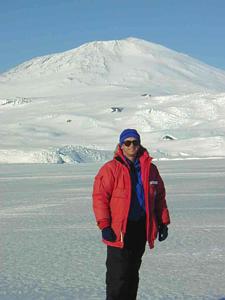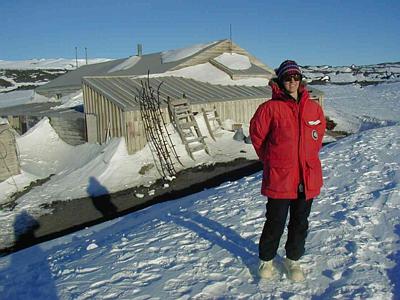16 November, 1999
McMurdo Station and Cape Evans, Antarctica Monday
Julie and I spent most of the morning learning the specifics involved with
our experiments and how they relate to the use the gas chromatograph. The
gas chromatograph will help us to calculate the amount of nitrous oxide in
our sample. When we have our first REAL day at the chromatograph, I will
explain the experiment we are doing in much more detail. I'll also include
a photograph of the instrument!
In the afternoon, Bess, Mark, and I loaded all of our equipment, including
sleep sacks in the event that weather strands us in the Dry Valleys, into a
truck and hauled it down to the helicopter pad. It was necessary to weigh
every item. Weights are especially important on a helicopter. The helos
can only provide so much lift and must be properly balanced. This took us
quite a long time!
Maite acid washed our sampling bags. Because we are interested in looking
at the concentration of the metals in Lake Bonney, the bags in which we put
the water must be completely free of metals. The bottles are filled with
10% hydrochloric acid and are allowed to sit for 2 hours. Then the bags are
triple washed with ultra-pure water. The ends of the bags (with the valves
and tubing that I put on a few days ago) are completely closed to outside
air and dust. All of the bags are then put into a clean zippered bag to
protect them. The analyst performing this procedure must wear clean gloves
at all times and usually changes her gloves often.
This evening we went to Cape Evans. We rode in a Delta, a vehicle with
incredibly large tires. They took us across the sea ice. Cape Evans is the
spot where Robert F. Scott built a hut in 1911 before attempting to be the
first person at the South Pole. The hut is set below Mount Erebus, an
active volcano. To this day, it remains as it was left when explorers
originally found it. Around the hut you can find hand-made nails, sleds,
food rations, a seal flipper (perfectly preserved), a dog carcass (partially
preserved), and many boxes filled with materials that the men needed to
survive the Antarctic winter. It's a sobering place amidst all of the
beauty because it reminds me of the harshness of the continent. It is
unforgiving. Unfortunately, someone neglected to return the key to the hut
so we were not able to go inside. I am hoping to make another such trip and
actually enter the hut! Enjoy the photos of the hut, Mt. Erebus, and the
surrounding area.
Answer to yesterday's question: This was a tough question! Perhaps you
guessed correctly if you looked on a globe. Most of the maps in the United
States show Antarctica the way I asked you to view the continent. If you
could have folded the map as it would appear on a globe (remember the Earth
IS round!) you would see that we must travel in a west-northwest direction.
This is confusing because West Antarctica is to the east of McMurdo! Are
you confused? Look at a globe and it will make more sense!
Today's question: Why doesn't it snow or rain in the Dry Valleys?
Polar Profile: Meet Julie Granger. Julie is originally from Quebec, Canada
but now resides in Princeton, New Jersey. She attended McGill University in
Montreal, Canada where she received her Bachelor of Science and her Master
of Science degrees in Biology. At McGill, Julie worked with Dr. Neil Price
and studied the nutritional iron physiology of marine bacteria. Today,
Julie is the lab assistant to Dr. Bess Ward, our polar profile from
yesterday! In her spare time, Julie is an Ultimate Frisbee fanatic! In
fact, Julie brought her Frisbee with her to Antarctica! Now that is
dedication! Julie also cross-country skis and eats a lot of unusual food
(at least, unusual for me)! She has already gotten me to eat sushi and
sardines!
Sharon
JUST FOR KIDS!!!!! Today, Julie and I learned how to operate a very special
piece of equipment called a gas chromatograph. We will use this after we
get our samples tomorrow. Bess, Mark, and I took all of our equipment that
we will need for our field trip, to the helicopter pad. All of the items
had to be weighed and marked. This is important so that the helicopter
pilot can balance the load. I don't want to get on a topsy-turvy helicopter
tomorrow!
In the evening, we went to Cape Evans, an area of Ross Island that is very
historic. It is where Robert F. Scott built a hut and lived before trying
to be the first person ever to reach the South Pole. This was in 1911. The
hut is set below Mount Erebus, an active volcano. To this day, it remains
as it was left when explorers originally found it. Around the hut you can
find hand-made nails, sleds, food rations, a seal flipper (perfectly
preserved), a dog carcass (partially preserved), and many boxes filled with
materials that the men needed to survive the Antarctic winter.
Answer to yesterday's question: This was a tough question! Perhaps you
guessed correctly if you looked on a globe. Most of the maps in the United
States show Antarctica the way I asked you to view the continent. If you
could have folded the map as it would appear on a globe (remember the Earth
IS round!) you would see that we must travel in a west-northwest direction.
This is confusing because West Antarctica is to the east of McMurdo! Are
you confused? Look at a globe and it will make more sense!
Today's question: Why doesn't it snow or rain in the Dry Valleys?
Polar Profile: Meet Julie Granger. Julie is originally from Quebec, Canada
but now lives in Princeton, New Jersey. She went to college in Canada and
studied bacteria that live in the ocean. Today, Julie is the lab assistant
to Dr. Bess Ward, our polar profile from yesterday! In her spare time,
Julie is an Ultimate Frisbee fanatic! In fact, Julie brought her Frisbee
with her to Antarctica! Now that is dedication! Julie also cross-country
skis and eats a lot of unusual food (at least, unusual for me)! She has
already gotten me to eat sushi and sardines!
Sharon

Mark Wells with a Mount Erebus backdrop. Mount Erebus is the only active volcano on the continent.

Sharon with a Weddell Seal. We were told not to get too close! Inaccessible Island is in the background.

Julie Granger, our Polar Profile for today. Julie is standing on sea ice in front of Inaccessible Island.

Sharon at Scott's Hut, Cape Evans.
Contact the TEA in the field at
.
If you cannot connect through your browser, copy the
TEA's e-mail address in the "To:" line of
your favorite e-mail package.
|
